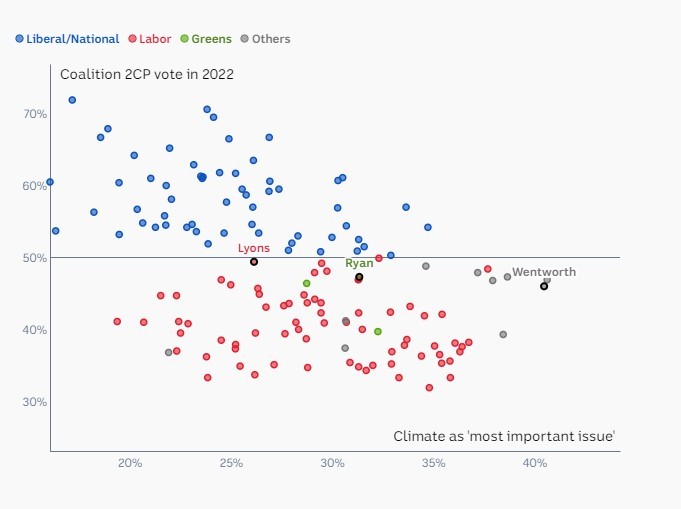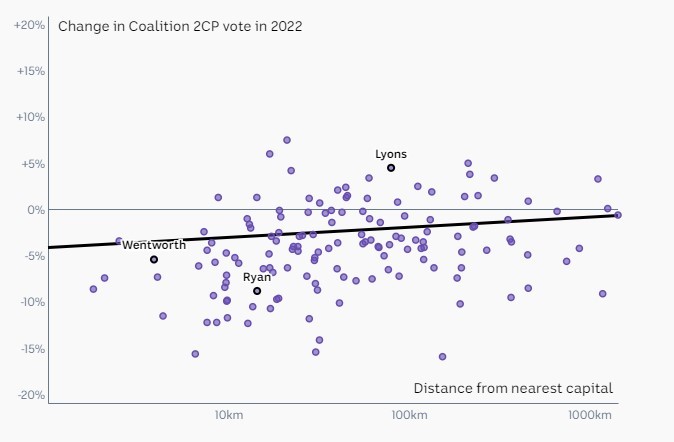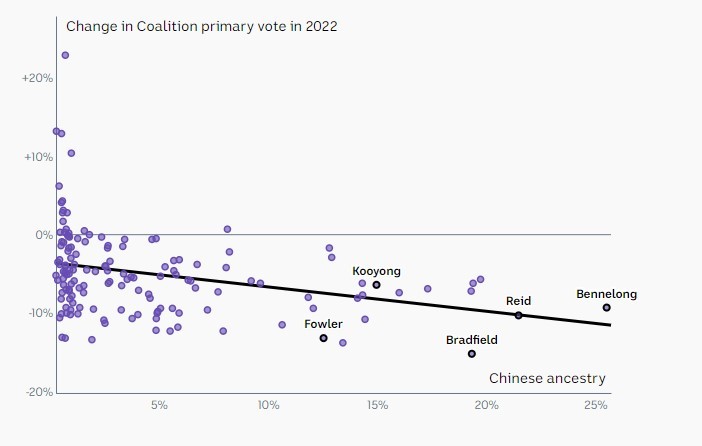
How Labor won FED2022 with less than a third of the primary vote and why The Greens and Independents did so well
By Mark Brogan, Climate Crisis Working Group, Greens (WA)
First posted on Mark Brogan’s page on LinkedIn
FED2022 upended the democracy sausage with a victorious Labor Party winning a majority of seats with a national primary vote count of only 32.6%. This was Labor’s worst primary vote since the 1930s and ordinarily would not have delivered it Government. But this was no ordinary election. A record number of Independents and Greens were also elected. How did the democracy sausage get upended in FED2022 and what might this mean for Australian democracy going forward?
We all do elections in our own way. Beset by the banality of political advertising, political spin, or personal circumstance, some disengage completely and are lost to the cause of sausage democracy. The deluge of advertising on television and social media, the ugliness of curb side corflutes, all just add to a sense of alienation. At the other end of the scale are the passionate, who volunteer for political parties and put in the hard yards of door knocking, letterboxing and handing out How to Vote cards on polling booths. These are the champions of sausage democracy.
I’ve been a candidate for the Greens in elections twice, but I did my FED2022 as a worker bee mostly in polling booth coordination and booth work in the Swan electorate in WA, supporting Greens candidates Clint Uink and Dorinda Cox. It was an active choice based on my experience and perception of the importance of booth work. Greens estimate that booth work can add 4% to the First Preference (FP) vote, compared with no booth representation. I did stints in both pre-poll voting and on election day.
Four percent (4%) may not seem much, but when amplification by preference voting is taken into account, it becomes significant in determining not only the fate of a party, but the election as a whole. This simple statistic is salutary in a way that many commentators on politics fail to comprehend. Opinion polls, policies and leadership are not the only game in town when it comes to handing out the keys to the Lodge. Organisation and operational effectiveness in harvesting votes are both critically important. Consider this a plea for a systems informed view of how our ‘democracy’ works. When you adopt a system view, inclusive of entities such as electoral systems, people, parties and resources, not only do you get a more informed view of how our democracy works, but you gain insight into how opinion poll leads do not necessarily translate into electoral triumphs.
Setting aside the systems stuff, FED 2022 was hilarious. The memes were so funny – leaking buckets, magic puddings and yes, even Yoda got a gig. (1) In jingle territory, we had an ear worm based on a popular nursery rhyme (2) that displaced whatever vestige of sanity was left after three wasted, toxic years of the Morrison Government. Former Abbott Press Secretary and corporate communications specialist, Claire Kimball came out on Gruen to tell us how clever this was.(3) Seen through the lens of the walloping LNP received on election night, we conclude that marketing is not a precise science, and yes Claire, you may have got this wrong! In many ways, FED2022 was a reminder that marketing should never displace meaningful politics and when it does, the outcome puts its limitations in clear view. For a Prime Minister with a marketing professional background, this was an omnipresent danger.
The campaign began with a so-called ‘gotcha moment’, a test of memory and awareness of data thought by the press corps too important for a competent politician to fail. For Leader of the Opposition, Anthony Albanese, this was the current unemployment rate. As Albanese squirmed like a worm on a hook, it was plain that the time of the ‘gotcha moment’ had arrived. But from a green perspective the gotchas were disappointing. What about current parts per million (ppm) CO2 in the atmosphere? (4) What about safe ppm CO2? (5) These numbers critically define the existential crisis posed to the biosphere by climate change. In an election full of gotcha moments, where seasoned politicians were called out for not doing their homework on policy detail, I sat patiently waiting for these gotcha moments to happen. But in this game of thrones, they never did. Nor was any politician asked how many hectares were burnt in the 2019-20 bushfires or animals incinerated (6) If this election was going to be some kind of referendum on the Morrison Government’s inaction on climate, this was news to the Australian media.
In pre-poll, I campaigned at the Cannington pre-poll, situated on a major arterial road. Seventy thousand cars pass this location everyday. This was a characterless, charmless place, bathed in billboard ugliness, that sat marooned and unwelcoming. If Satan is going to manifest himself to contemporary man, I offer the opinion that it will be at the Cannington pre-poll. With the six metre rule in operation, booth workers, candidates and party volunteers did their work amid the ebb and flow of moving vehicles. Intimidation and injury by automobile, was an omnipresent risk to both voters and volunteers.
Election campaigns are contests of many things – perception, strategy, policy, and pork. With the aid of data, the election result can be explained in reference to each.
The politics of perception
Voter perceptions are shaped by advertising, communications and effective campaign strategy. Effective strategy emphasizes the perceived strengths of your own side and, conversely, apparent weaknesses of your opponent. In FED2022, the Morrison Government’s perception ammunition was primed and ready to fire. Most hits on the Opposition came from across the lines, but some hits were self inflicted. In the first day of the official campaign on 11 April, Albanese misquoted the current unemployment rate, delivering a welcome but unexpected gift to the Morrison Government. (7)
In perception management terms, gaffes are pennies from heaven. They can embed negative tropes and switch momentum. Morrison was quick to pounce, framing the Opposition Leader as incompetent, a leader on training wheels and someone without economic credentials. This was all the more painful for Albanese, since the gaffe dovetailed with a Labor advertising campaign parading his economic management credentials. With blood in the water, the media pack served up another ‘gotcha moment’ two weeks out from election day with Albanese’s fumble over Labor’s six point plan for the NDIS . (8) But it wasn’t all about gotcha moments. The selective interpretation of economic and climate data, the framing of government under the Teals as chaos (9) were all tactical plays in motion from the Morrison Government aimed at shifting voter perceptions on sensitive issues.
Of course the Opposition played its own perception game. Morrison’s “I don’t hold a hose” line became a trope for a Prime Minister who was uncaring, untrustworthy, incompetent and missing in action. (10) With few runs on the board and perception problems of its own, Morrison necessarily relied more heavily on the discrediting of his opponent with negative tropes, in what seemed at the time a tsunami of attack ads. For a while it looked like it might work i.e. before the Reserve Bank brought the conversation back to earth with an exquisitely timed interest rate rise on May 3. (11) Presto. Politics fell to earth with a thud and refocussed on the real world pain to households of price inflation, housing affordability and the cost of living.
Strategy: The engineering of division with fear and loathing
Once thought of as a fun thing that teenagers did to each other, wedging has been reinvented by political strategists as a strategy for winning marginal seats. Wedges shift voting behaviours, often with appeals to prejudice or self interest. Morrison wedged Labor’s retiree vote in 2019 with a well orchestrated scare campaign organized around the abolition of franking credits and negative gearing. (12) Most retirees have no or insignificant income from franking credits. Most don’t have investment properties. But the campaign instilled fear in the target audience and worked. Morrison did the same in 2019 with Labor’s climate policy in regional coal dependent seats. (13)
What worked in FED 2019 was re-jigged and re-minted for FED 2022. But with Labor’s small target strategy heading into FED2022, wedge opportunities were less plentiful and required social engineering. This developed initially around Morrison’s pick for the seat of Warringah, Katherine Deves, who ran on a platform that opposed trans gender athletes competing in women’s sport. (14) Two days into the campaign, Labor denounced the Government’s support for Deves as ‘dogwhistle politics’ aimed at ultraconservatives. (15) Morrison was not for changing and stuck with his Warringah pick, despite calls from moderates within his party that she be dis-endorsed.
But the Government was not done with fear and loathing. In the dying hours of the campaign, when news came of an intercepted Sri Lankan refugee boat, Morrison sought to re-ignite fears of boat people with rollout of the news to electors via SMS. But it came too late to make a difference. What worked so well in 2019, could not be re-engineered in 2022 with the same effect. In Warringah, Deves could not make inroads into the Two Candidate Preferred (2CP) vote of the Independent incumbent, Zali Stegall. Stegall ended up achieving a +3.7% swing. Something had changed.
Policy soup
The policy contest was considered by most pundits to be minor in the overall outcome, with not much difference between the two majors. The origins of this shared view was media consensus that Labor had learnt from FED2019 and gone into the campaign wanting to offer a small target that provided fewer opportunities for ‘wedging’. Portraying the choice between the two majors as vanilla, looked like a tactic that would play out to the advantage of the incumbent government. If the alternative is no different, why vote for them? However, commentators who took the time to read and analyse policy found differences on climate and energy, integrity in government, gender, human rights, foreign policy and indigenous affairs.
On climate, industry analysts Climate Analytics, found that the Opposition’s policies were consistent with a two (2) degrees Celsius global warming pathway and the Government’s three (3) degrees. (16) Only the Greens and Teal independents were found to have policies consistent with the 1.5 degrees, safer, Paris Agreement pathway. These differences sound small but the underlying scientific reality is the difference between a basically habitable world and a world in transition to the uninhabitable. Light and day differences also existed on a the need for a Federal anti-corruption commission. Gender politics were also in play. The Morrison Government’s ‘women problem’ came into clear focus with thoughtful differentiation by Labor, the Greens and Independents on issues such as child care and pay equity. The danger to the Coalition in failing to address issues important to women grew as Labor, the Greens and Independents delivered on their own perception strategy. A strategy that framed the Government as sexist and un-caring.
Post election analysis suggests that the success enjoyed by the insurgent Greens and Teal Independents candidates in city electorates played out because voters looked for real action on issues that mattered to them. Highlighting the rise of gender politics, all of the Teal Independents who got elected were intelligent, professional women. Voters were not buying into business as usual from the two major parties on issues of concern to them. The blood letting was most profound for the Liberals, who lost eighteen (18) seats, ten (10) of which went to Labor and seven (7) to independents. Greens also had a memorable night adding three (3) seats in the House of Representatives and returning six (6) senators. Both majors suffered a decline in their Two Candidate Preferred (2CP) vote – the Liberals -5.7% nationally and Labor -0.8%.
National averages, however, mask the magnitude and variability of some swings – in Fowler ALP front bencher Christine Keneally lost to an Independent on -15.6% swing. In Pearce, what had been a safe Liberal seat with Christian Porter, was won by Labor on a swing of -14.2%. Swings from the incumbent Liberals to Independents elsewhere (Curtin, Goldstein, Kooyong, MacKellar, North Sydney, Waringah and Wentworth) averaged a whopping -10.3%. The effect was to wipe out Liberal ‘moderates’ in seats that were previously regarded as reasonably safe.
More heat and energy is generated by competing understandings of election results than by volcanic eruptions. Reliable understanding needs to be grounded in data describing voter attitudes, demographics and electorate specifics. ABC and Guardian Australia came closest to achieving this in their post election analysis. This analysis scrutinized factors in the 2CP vote drift to Independents and the Greens, using real data describing attitudes, demographics and electorate outcomes. The drift began in 2019 with swings insufficient to dislodge LNP candidates, but proved devastating to conservative hopes in 2022. The analysis by ABC’s Story Lab included the following graphic showing the percentage of voters by electorate who considered climate change the most important issue (x-axis) plotted against the Coalition 2CP % vote in the election (y-axis) (17):

Inspection shows, that as the percentage of voters for whom climate change was the most important issue increased, the likelihood of the seat changing hands also increased. In and of itself, this is not revelatory, after all you would expect electorates with greater percentages of voters concerned about climate to vote Labor or Green. And this happened in Brisbane where a -10.1% first preference vote against the LNP, translated into a win for Greens candidate, Stephen Bates. But elsewhere votes went to the Teal Independents, and this is where damage to the LNP was greatest. For example in Wentworth, where Dave Sharma lost his seat to Teal independent Allegra Spender, the Labor Party 2CP was down 0.2% and the Greens vote up only 0.8%. The 6.9% swing against the Liberals went to Allegra Spender (+3.4%) with the remainder shared by United Australia, the Liberal Democrats and One Nation. The progressive, Teal candidate, with a strong position on climate, received the lion’s share of the swinging vote.
The data, however, as a whole, across all 151 electorates in play, was less convincing. It showed only a ‘weak association’ between intensity of feeling about climate and voting behaviour. (18) Tantalising as this research is, pointing towards some contribution from attitude to climate, the ‘weak’ nature of the association suggests the need for a richer model of behaviour inclusive of more variables and data. For example, if we added intensity of feeling about integrity of government in a multi-variate model, would the strength of association grow? What about attitude to violence against women or affordable child care?
Some insight into how additional factors that make up a multi-variate model might produce better understanding is provided when the Story Lab analysis moves on to consider the electorate location in terms of A. distance from the nearest capital city and B. Chinese ethnicity:
A. Change in Coalition 2CP vote 2022 v. Distance from nearest capital

The data again are not closely packed against the line of best fit, but do generally suggest a city rural divide in terms of swing data.
B. Change in Coalition primary vote in 2022 v. % voters of Chinese ancestry

In FED2022, the Coalition primary vote in electorates with larger percentages of voters with Chinese ancestry were also more likely to have experienced larger swings against the Government. These swings helped to elect Labor (Reid, Bennelong) or Independent candidates (Fowler, Kooyong).
Throwing the pork on the barbie
Pork barrelling is the practice of bribing voters with sweeteners that work at local level – sports grants, car parks, community centres, roads and the like. The Morrison Government had pork barrelled on a grand scale in FED2019. Having won an unwinnable election in 2019, Morrison looked for it to deliver again in FED2022. By election day, the total amount promised by the Coalition for both electorate-only and state wide projects since the start of the campaign was $7.5bn, compared to $4.9bn promised by Labor. (19)
Return On Investment (ROI), however, proved elusive for the LNP. With collateral damage from sports rorts, an integrity hangover from pork barrelling in FED2019, inaction on a Federal ICAC and other probity factors, it was unlikely that the pork would sizzle as it had in 2019. And it didn’t. The data analytics team of Josh Nicholas and Nick Evershed at Guardian Australia could find no correlation between swing and the amount of money promised in an electorate during the FED2022 campaign.(20)
Conclusions
Coming into FED2022, the LNP Government carried baggage across most public policy areas. This is by no means unusual for a Government that had enjoyed longevity over a period of nine years under three leaders. But the pile of voter discontent was broad and growing – across climate and energy policy, cost of living pressures, gender and integrity. Division within its own ranks about its identity as a conservative v. republican v. liberal progressive party added to the pile. When Governments pile up enough baggage, drag can turn to toxicity. Toxicity can be seen in the visceral voter reaction to Morrison suggested by unsuccessful Wentworth Liberal moderate, Dave Sharma. Very probably many Australians never forgave Morrison for taking a holiday during the 2019/20 catastrophic bushfires.
Even with undeniable gaps in the quantitative analysis, a picture emerges of an electorate galvanized into action over policy and performance short comings. Perception management and wedge politics can always leverage votes, but they could not leverage enough for the LNP in FED2022. They could not leverage enough because in affluent, educated, city LNP incumbent electorates, a credible, conservative non-Labor alternative was available. These were the electorates of Curtin (WA), Goldstein, Kooyong, MacKellar, North Sydney and Wentworth. Liberal voters did not have to vote Labor or Green to punish the Morrison Government. Across all of these electorates, can be seen a direct transfer of votes from incumbent Liberals to Teal Independents. In Queensland, in seats with no Teal challenge, distaste for the Morrison Government elected Greens candidates, Stephen Bates in Brisbane and Max Chandler-Mather in Griffith.
What does all of this mean for FED2025 and the future of Australian politics? The focussing of the electorate’s mind on climate change, integrity, equity and cost of living is unlikely to have been transitory. The potential for the Albanese Government to disappoint is real. It may be just as easy for Albanese to be on the receiving end in FED2025, as the LNP was in FED2022. History also shows that once established, Independents and Greens can be difficult to dislodge. In Waringah, sitting Independent Zali Steggall increased her 2CP vote by 3.5%. In Indi, sitting Independent Helen Haines recorded a 7.4% swing. In Tasmania, in Clark, Andrew Wilkie was the only re-contesting Independent to record a negative swing (-1.8%) on 2CP vote of 70.4%. Greens leader Adam Bandt in Melbourne received a +1.7 swing on the primary vote.
The hollowing out of the vote for the two majors also shows a break down in the Anglo centric male hegemonic nature of Australian politics. Whilst this promises more diverse voices and representation into the future, it also suggests a growing role for the fringe right, a phenomenon that has fundamentally re-shaped American politics. And if you think the impact of climate change is a one off, think again. According to the World Meteorological Organization, there is a 50% chance that the world will exceed the 1.5 degrees Celsius threshold for global warming within five years. (21) The impacts of climate change will be ongoing, more frequent and more severe. If Australian politics was re-shaped by climate in 2022, this re-shaping is set to continue.
In the wake of the defeat, Morrison still didn’t get it. People change the curtains he said. Its what people do.
ENDNOTES:
(1) McCormack, A. (2022). The Memes of the 2022 Election (so far). Retrieved from:https://farragomagazine.com/article/farrago/The-Memes-of-the-2022-Elect…
(2) Liberal Party of Australia. (2022). There’s a Hole in Your Budget, Dear Labor (Club Remix). Retrieved from: https://youtu.be/P2Tp8_7glXs
(3) Australian Broadcasting Corporation. (2022). Gruen Nation. Series 3 Episode 1. Retrieved from: https://iview.abc.net.au/video/LE2126H001S00
(4) In May, 2022, 420.99 ppm. Vide CO2 Earth- Numbers for living on Earth. https://gml.noaa.gov/ccgg/trends/mlo.html
(5) Estimated at 280-350 ppm. Vide MIT Climate Portal. What is the ideal level of carbon dioxide in the atmosphere for human life? Retrieved from: https://climate.mit.edu/ask-mit/what-ideal-level-carbon-dioxide-atmosph…
(6) Whiteman, H and Ritchie, H. (2022). How will they vote?: The ‘lucky country’ is facing a crucial test. The result will affect us all. Retrieved from: https://edition.cnn.com/2022/05/17/australia/australia-election-climate…
(7) Butler, J. (2022). Monday election briefing: Anthony Albanese stumbles out of the gate. Guardian Australia, 11 April, 2022. Retrieved from: https://www.theguardian.com/australia-news/2022/apr/11/monday-election-…
(8) Murphy, K & Butler, J. (2022). Anthony Albanese bemoans campaign focus on ‘soundbites rather than values’ after forgetting NDIS detail. Guardian Australia, 5 May, 2022. Retrieved from: https://www.theguardian.com/australia-news/2022/may/05/anthony-albanese…
(9) Sheridan, G. (2022). Teals play the electoral system for a sucker. The Australian May 3, 2022.
(10) Shepherd, T. (2022). ‘I don’t hold a hose’: do Labor’s attack ads hit hard enough? Guardian Australia, 28 April, 2022. Retrieved from: https://www.theguardian.com/australia-news/2022/apr/28/i-dont-hold-a-ho…
(11) Hannam, P. (2022). Reserve Bank interest rates: RBA lifts official cash rate to 0.35% in first rise since 2010. The Guardian Australia, 3 May, 2022. Retrieved from: https://www.theguardian.com/australia-news/2022/may/03/reserve-bank-of-…
(12) Karp, P. (2019). Chris Bowen angrily defends negative gearing costings and reveals tax timeline. The Guardian Australia, 10 April, 2019. Retrieved from: https://www.theguardian.com/australia-news/2019/apr/10/chris-bowen-angr…
(13) Martin, S. and Smee, B. (2019). Australian election: Queesland drives a stake through Labor’s hopes. Guardian Australia, 18 May, 2019. Retrieved from: https://www.theguardian.com/australia-news/2019/may/18/australian-elect…
(14) Martin, S. & McGowan, M. (2022). Katherine Deves cliams key role in controversial bill to ban trans women from women’s sport. Guardian Australia, 19 April, 2022. Retrieved from: https://www.theguardian.com/australia-news/2022/apr/19/katherine-deves-…
(15) Hurst, D. & Karp, P. (2022). Independents accuse Morrison of using trans sport ban as a ‘dog-whistle to the ultraconservatives.’ The Guardian Australia, 12 April, 2022. Retrieved from: https://www.theguardian.com/australia-news/2022/apr/12/independents-acc…
(16) Climate Analytics. (2022). Australian election 2022 political party and independent climate goals: analysis. Retrieved from: https://climateanalytics.org/publications/2022/australian-election-2022…
(17) Story Lab. (2022). How the seeds of the 2022 election result were sown years ago. Retrieved from:https://www.abc.net.au/news/2022-05-31/federal-election-voting-trends-c…
(18) No R-Squared value was quoted describing goodness of fit.
(19) Martin, S. and Evershed, N. (2022). $8m an hour: in the battle for marginal seats, it’s a contest of who can splurge the most. The Guardian, 21 May, 2022. Retrieved from: https://www.theguardian.com/australia-news/2022/may/21/8m-an-hour-in-th…
(20) Noicholas, J. & Evershed, N. (2022). Votes for Labor and the Coalition plummet to all-time low as Australia swings away from major parties. Guardian Australia, 28 May, 2022. Retrieved from:https://www.theguardian.com/news/datablog/2022/may/28/votes-for-labor-a…
(21) Vetter, D. (2022). Earth Stands ‘50:50’ Chance Of Passing 1.5 Degrees Warming Within 5 Years. Forbes: Sustainability. Retrieved from: https://www.forbes.com/sites/davidrvetter/2022/05/10/earth-stands-5050-…
Header photo: Based on an original 2005 image of Parliament House Canberra by Andrea Schaffer. Licensed under CC 2.0
[Opinions expressed are those of the author and not official policy of Greens WA]
The content above from the originating party/author(s) may be of a point-in-time nature and edited for style and length. The views and opinions expressed are those of the original author(s). View original.
AusPol.co Disclaimer

